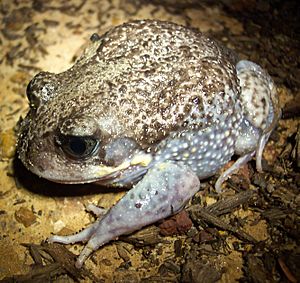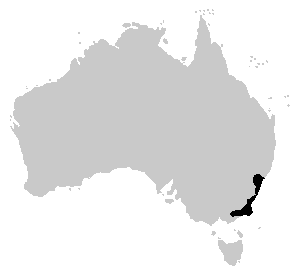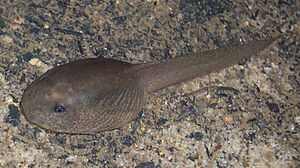Giant burrowing frog facts for kids
Quick facts for kids Giant burrowing frog |
|
|---|---|
 |
|
| Conservation status | |
| Scientific classification | |
| Genus: |
Heleioporus
|
| Species: |
australiacus
|
 |
|
| Range of the giant burrowing frog | |
| Synonyms | |
|
|
The giant burrowing frog or eastern owl frog (Heleioporus australiacus) is a large frog species. It lives in coastal parts of southeastern New South Wales and Victoria in Australia. These frogs are known for their special way of living underground.
Contents
About the Giant Burrowing Frog
This frog is quite big, growing up to 10 centimeters (about 4 inches) long. Its back can be grey, dark brown, or black. Its belly is white. You might see yellow spots on its sides. It also has a yellow stripe on its upper lip. This stripe runs from behind its eye to the back of its ear drum area (called the tympanum). When young frogs are changing from tadpoles, this stripe is pink-orange.
The skin of the giant burrowing frog feels rough and bumpy. During the time they mate, male frogs often grow small black spines on their fingers. Their eyes have a silver color, and their pupils (the dark part in the middle of the eye) are shaped like a vertical line.
Where They Live and How They Behave
These frogs live in different types of forests. You can find them in sandstone heathland, dry forests, and wet forests. Their home stretches from north of Sydney down to eastern Victoria. They are called "burrowing frogs" because they are very good at digging and living underground.
They are also known as the "eastern owl frog." This is because of the sound the males make to attract a mate. It sounds a lot like an owl hooting!
Life Cycle and Reproduction
Male frogs call from their burrows (their underground homes). They do this near the edges of streams. This usually happens in autumn and spring, especially after a lot of rain.
The female frogs lay their eggs inside these burrows. These burrows are on the banks of creeks and streams. When heavy rain comes, the eggs get washed into the water. The tadpoles then grow and develop in the creek. This can take a long time, from 3 to 11 months. Giant burrowing frog tadpoles are very large, growing up to 80 millimeters (about 3 inches) long.
Mistaken Identity
The giant burrowing frog is the largest frog in Victoria. Because it is big (9 to 10 cm) and has bumpy skin, people sometimes confuse it with the cane toad. However, there are clear differences. Cane toads do not have vertical pupils like the giant burrowing frog. Also, cane toads do not currently live in the same areas as the giant burrowing frog.
You might see these frogs at night, especially after it rains. They sometimes sit on the edges of roads and walking tracks in places where they like to live. Sadly, the number of these frogs has gone down. This is because cities and towns have grown. Now, they mostly live in protected areas like National Parks and State Forests.
See also
 In Spanish: Rana excavadora gigante para niños
In Spanish: Rana excavadora gigante para niños



